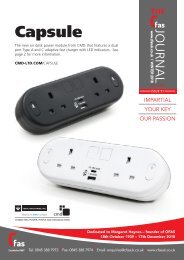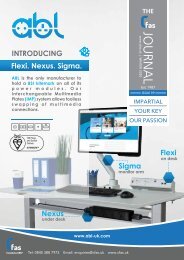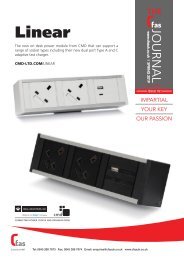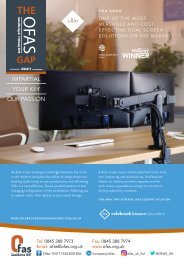Spring 2016
Spring 2016
Spring 2016
You also want an ePaper? Increase the reach of your titles
YUMPU automatically turns print PDFs into web optimized ePapers that Google loves.
Top<br />
Tips<br />
for Ergonomics in the Office<br />
There is significant scope for organisations to improve efficiency, health and safety and<br />
employee satisfaction by applying ergonomics in the working environment.<br />
Ergonomically designed<br />
workplaces, equipment<br />
and jobs aim to modify<br />
the environment to meet<br />
people’s needs. A furniture<br />
expert explains why<br />
ergonomics is important.<br />
“Ergonomics is the<br />
application of scientific<br />
information concerning<br />
humans to the design<br />
of objects, systems and<br />
environments for human<br />
use. Ergonomics comes into<br />
everything which involves<br />
people. Work systems,<br />
sports and leisure, health<br />
and safety should all embody<br />
ergonomics principles if well<br />
designed.” explains Levent<br />
Çaglar, Head of Ergonomics<br />
at FIRA International.<br />
Some areas to be considered in the office are:<br />
1.Safety<br />
• Safety is obviously the first concern – make sure products are safe, stable and fit for<br />
purpose by only using those that comply with current British Standards.<br />
2.Workstations<br />
• Make sure the workstation is large enough to accommodate all the users’ needs and<br />
equipment.<br />
• The use of height adjustable desking is recommended so that all staff can use a desk<br />
comfortably.<br />
3.VDU’s and keyboards<br />
• The optimal eye to monitor distance is 600mm, however some users may have different<br />
preferences and distances, between 500mm and 750 mm are acceptable.<br />
• There should be 100mm from the front edge of the workstation to the keyboard so that<br />
users can rest their wrists.<br />
4.Office seating<br />
• The seat must be compatible with the workstation, especially height, so easily adjustable<br />
seating is preferred.<br />
5.Lighting and temperature<br />
• Lighting and temperature can also influence a worker’s comfort and performance.<br />
• For general office working the recommended lighting level is around 500 lux, although<br />
walkways etc. may need higher lighting levels.<br />
• Getting the right temperature for all workers can be a challenge; the recommended<br />
temperature is between 19°C to 23°C, but find out what works best for the majority of<br />
your staff and work with that.<br />
When designing an ergonomic office remember that everybody is different,<br />
so try to allow for personal preferences wherever possible.<br />
To find out more about Office Ergonomics, Contact:<br />
T - 01438 777 700 | E - info@fira.co.uk | W - www.fira.co.uk<br />
18 www.ofas.org.uk SPRING <strong>2016</strong>
















